What you need to know about Lichen flat disease
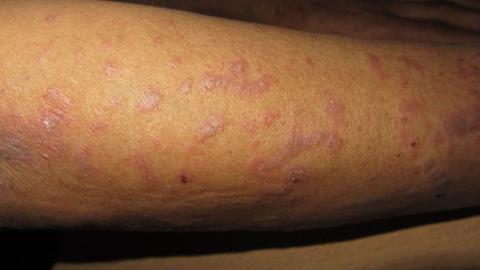
Lichen planus is a disease that causes inflammation in many different locations on the body. Patients may experience hair loss, itching, or pain that affects quality of life. Let's learn about flat lichen with SignsSymptomsList through the following article!
content
- 1. What is flat lichen?
- 2. What are the signs of flat lichen?
- 3. Causes and risk factors for lichen planus
- 4. Danger of Lichen Flat Disease
- 5. What tests are needed to diagnose lichen planus?
- 6. Flat lichen treatments
- 7. Patient's home lifestyle
1. What is flat lichen?
Lichen planus is swelling and irritation in areas such as skin, hair, nails, and mucous membranes. On the skin, lichen planus is characterized by a flat, pruritic, purple-red papule that progresses over several weeks. In the mouth, vagina, and mucosal sites, lichen planus takes the form of white patches and is sometimes accompanied by painful ulcers.
Most patients can self-treat at home for typical and mild forms of lichen planus without going to the hospital. If the disease causes a lot of pain or itching, the patient can use topical medicine after being consulted and prescribed by a doctor. Lichen planus is not contagious.
2. What are the signs of flat lichen?
Flat lichen causes many different symptoms, depending on the location of the body. Typical symptoms include:
- Flat, red-violet papules, often appearing on the facial skin on the forearms, wrists, ankles, or sometimes the genitals.
- Itchy.
- The blisters burst and crust over.
- White patches in the mouth, on the lips or on the tongue.
- Painful sensation in the mouth or vagina.
- Hair loss.
- Change in scalp color.
- Damaged or missing nails.
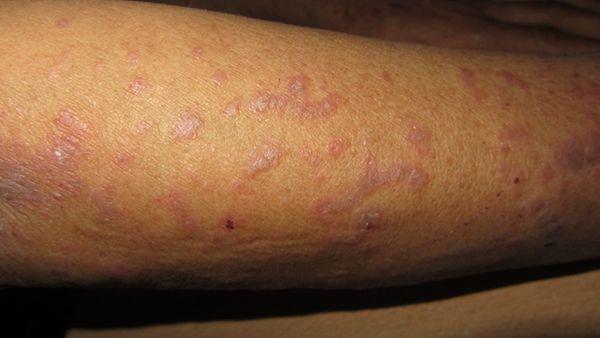
Skin lesions due to lichen planus.
3. Causes and risk factors for lichen planus
Flat lichen occurs when a person's immune system attacks their own skin or lining cells. It is currently unclear why this abnormal immune response occurs. Because of the mechanism of the immune system abnormality, lichen planus is not contagious from person to person.
The following conditions can cause lichen planus:
- Hepatitis C .
- Get the flu vaccine.
- Certain chemicals, dyes and metals.
- Pain relievers, such as ibuprofen and naproxen.
- Some medications are used to treat heart disease, high blood pressure, or arthritis.
Anyone can get lichen planus. However, the disease affects most middle-aged people. Oral lichen planus is most common in middle-aged women.
>> See more: Treatment of skin inflammation with Beprosalic cream
4. Danger of Lichen Flat Disease
Flat lichen planus lesions appearing on the vulva and vagina are often painful, sometimes scarring, and difficult to treat. Getting sick in these sensitive areas can lead to long-term sexual dysfunction. In the oral region, ulcers can affect the patient's ability to eat and drink. In addition, lichen planus may be darker than the surrounding areas even after it has recovered, especially in people who already have darker skin.
Flat lichen of the mouth increases the risk of oral cancer. If left untreated, flat lichen in the ear canal can cause complications with hearing loss.
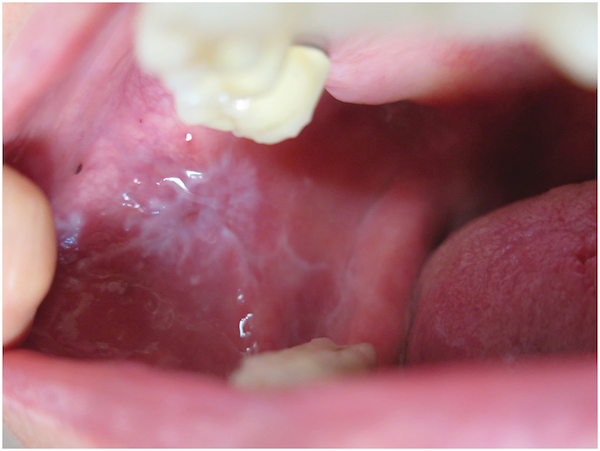
Flat lichen of the mouth increases the risk of oral cancer.
Therefore, you should see your doctor if you have small papules or rash-like symptoms on your skin for no apparent reason. In addition, if the above symptoms appear in the mouth, genitals, scalp or nails. You should also see a doctor early for a timely diagnosis, to avoid long-term damage and discomfort affecting life.
5. What tests are needed to diagnose lichen planus?
Your doctor will base on your symptoms, previous medical history, physical exam, and some of the tests needed to diagnose lichen planus. Your doctor may do the following tests:
- Biopsy . A tissue sample of the symptomatic area is taken for microscopic examination. The doctor will then look for cells that are characteristic of lichen planus.
- Get tested for hepatitis C because it can cause lichen planus.
- Allergy test. The doctor will look to see if the person is allergic to any of the agents that cause lichen planus.
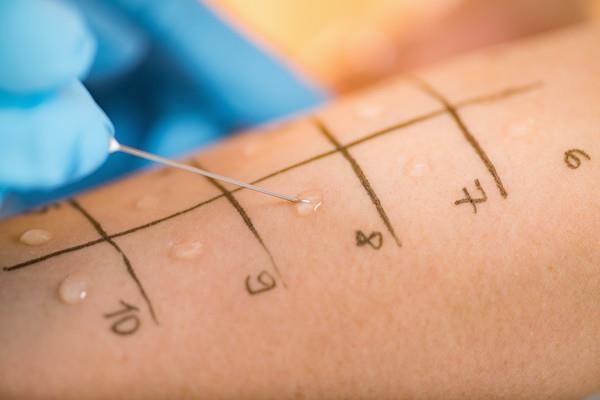
Allergy testing for the causative agent of lichen planus.
Other tests may also be needed if the doctor suspects that a patient has lichen planus variants in areas such as the esophagus, ears, mouth, or genitals.
6. Flat lichen treatments
Flat lichen on the skin usually clears up on its own after several months to several years. However, the disease in the mucosal area is resistant to treatment and easy to recur. Regardless of the treatment method used, patients should have regular check-ups once a year.
Using medications and other treatments can help relieve itching, relieve pain, and promote healing. Patients should talk to their doctor about the benefits and harms of each method.
6.1. Corticosteroids
The first choice in the treatment of lichen planus is usually a corticosteroid cream or ointment. If that doesn't work, your doctor will switch to oral or injectable corticosteroids.
Common side effects of corticosteroids include irritation or thinning of the skin at the site of application and oral thrush. Therefore, corticosteroids should be used for a short period of time and as directed by a doctor.
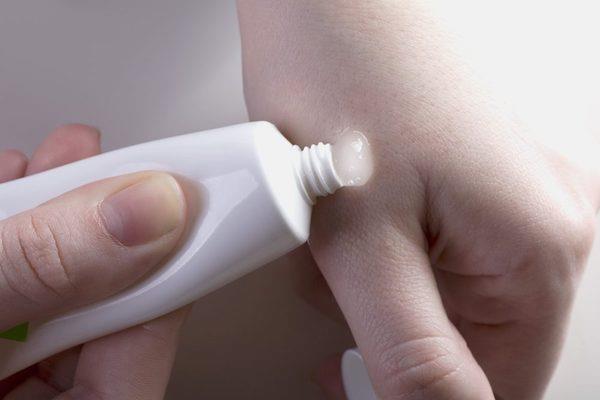
Long-term use of topical corticosteroids can bring about many side effects.
6.2. Oral antibiotics
Some options include the antimalarial drug hydroxychloroquine and the antibiotic metronidazole.
6.3. Immunosuppressive drugs
Patients with severe symptoms may need this medication to suppress the body's immune response. Some of the drugs in this class include zathioprine, mycophenolate, cyclosporine, and methotrexate.
6.4. Antihistamines
Antihistamines help relieve the itching caused by lichen planus.
6.5. Light therapy
This therapy helps to improve areas of flat lichen skin. The most common method of phototherapy is using UVB rays because this rays only penetrate the epidermis (outermost layer of skin). Patients need treatment 2-3 times / week and last for several weeks.
People with darker skin should not use light therapy because of the risk of darker skin.
6.6. Retinoids
If you don't respond to corticosteroids or light therapy, your doctor will prescribe an oral retinoid, such as acitretin.
Retinoids can cause birth defects and should not be used by women who are pregnant or may become pregnant. If the patient is pregnant or breastfeeding, the doctor will postpone the retinoid therapy and switch to another treatment method.
6.7. Treatment of flat lichen trigger factor
If lichen planus is suspected to be caused by hepatitis C, an allergy, or a medication the patient is taking; The doctor will focus on addressing that factor. For example, patients may need to switch to lichen planar activators or avoid allergen exposure. If the cause is hepatitis C, a doctor who specializes in liver disease will treat the cause.
7. Patient's home lifestyle
The following measures can help relieve itching and discomfort caused by lichen planus:
- You can soak your body in a bath with finely ground oats (also known as colloidal oats). Then, apply moisturizer on your body.
- Cool compress.
- Use a cream or ointment containing hydrocortisone bought from a drugstore. Patients should only use this cream if they are not applying corticosteroids as prescribed by their doctor. The cream or ointment should contain at least 1% hydrocortisone.
- Avoid scratching or scratching the skin.
If you have lichen planus in your mouth, you should clean your teeth carefully and visit your dentist regularly. The pain of mouth sores can be reduced by avoiding the use of:
- Cigarette.
- Wine.
- Eat spicy foods or acidic foods and drinks.

Avoid eating spicy foods, alcohol, ... when you have flat lichen in the mouth.
Patients can also use some aloe-based supplements, such as applying aloe vera gel for flat lichen of the mouth or vulva. Methods that help reduce stress also offer some benefits because stress makes symptoms of lichen planus worse.
Flat lichen is caused by the immune system and is not contagious. The disease can cause pain, itching, and discomfort for the patient. Treatment can help relieve symptoms and speed recovery. Therefore, if the above symptoms appear, you should see a doctor for proper diagnosis and treatment, to avoid dangerous complications such as oral cancer.
Doctor Dao Thi Thu Huong